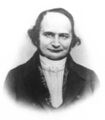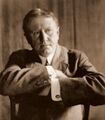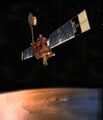Template:Selected anniversaries/September 11: Difference between revisions
No edit summary |
No edit summary |
||
| (10 intermediate revisions by the same user not shown) | |||
| Line 2: | Line 2: | ||
File:Martin Waldseemüller.jpg|link=Martin Waldseemüller (nonfiction)|1470: Mapmaker [[Martin Waldseemüller (nonfiction)|Martin Waldseemüller]] born. He will produce a globular world map and a large 12-panel world wall map using the information from Columbus and Vespucci's travels (Universalis Cosmographia), both bearing the first use of the name "America". | File:Martin Waldseemüller.jpg|link=Martin Waldseemüller (nonfiction)|1470: Mapmaker [[Martin Waldseemüller (nonfiction)|Martin Waldseemüller]] born. He will produce a globular world map and a large 12-panel world wall map using the information from Columbus and Vespucci's travels (Universalis Cosmographia), both bearing the first use of the name "America". | ||
||1717: Pehr Wilhelm Wargentin born ... astronomer and demographer. Pic. | ||1717: Pehr Wilhelm Wargentin born ... astronomer and demographer. Pic. | ||
| Line 23: | Line 21: | ||
File:Joseph Nicollet.jpg|link=Joseph Nicollet (nonfiction)|1843: Mathematician and explorer [[Joseph Nicollet (nonfiction)|Joseph Nicollet]] dies. He mapped the Upper Mississippi River basin during the 1830s. | File:Joseph Nicollet.jpg|link=Joseph Nicollet (nonfiction)|1843: Mathematician and explorer [[Joseph Nicollet (nonfiction)|Joseph Nicollet]] dies. He mapped the Upper Mississippi River basin during the 1830s. | ||
||1847: Mary Watson Whitney born ... astronomer and academic. | ||1847: Mary Watson Whitney born ... astronomer and academic. Pic. | ||
File: | File:William Sydney Porter.jpg|link=O. Henry (nonfiction)|1862: Short story writer [[O. Henry (nonfiction)|O. Henry]], known for his surprise endings, born. | ||
||1862: Hawley Harvey Crippen born ... physician and murderer ... telegraph. Pic. | |||
||1877: James Jeans born ... physicist, astronomer, and mathematician. Pic. | ||1877: James Jeans born ... physicist, astronomer, and mathematician. Pic. | ||
||1890: Felice Casorati dies . | File:Felice Casorati.jpg|link=Felice Casorati (nonfiction)|1890: [[Felice Casorati (nonfiction)|Felice Casorati]] dies. Casorati is best known for the Casorati–Weierstrass theorem in complex analysis. | ||
||1910: Fritz Karl Preikschat born ... electrical and telecommunications engineer and inventor. Pic. | ||1910: Fritz Karl Preikschat born ... electrical and telecommunications engineer and inventor. Pic. | ||
||1917: Kenkichi Iwasawa born ... mathematician who is known for his influence on algebraic number theory. | ||1917: Kenkichi Iwasawa born ... mathematician who is known for his influence on algebraic number theory. Pic search. | ||
||1926: Heini Halberstam born ... mathematician, working in the field of analytic number theory. He is one of the two mathematicians after whom the Elliott–Halberstam conjecture is named. | ||1926: Heini Halberstam born ... mathematician, working in the field of analytic number theory. He is one of the two mathematicians after whom the Elliott–Halberstam conjecture is named. Pic search. | ||
||1936: Herman Haga dies ... physicist. Pic. | ||1936: Herman Haga dies ... physicist. Pic. | ||
||1940: George Stibitz performs the first remote operation of a computer. | ||1940: George Stibitz performs the first remote operation of a computer. Pic. | ||
||1943: Mathematician Oswald Teichmüller dies. Pic. | ||1943: Mathematician Oswald Teichmüller dies. Pic. | ||
| Line 49: | Line 47: | ||
||1972: Johannes de Groot dies ... mathematician, the leading Dutch topologist for more than two decades following World War II. Pic. | ||1972: Johannes de Groot dies ... mathematician, the leading Dutch topologist for more than two decades following World War II. Pic. | ||
||1986: Henry DeWolf Smyth dies ... physicist, diplomat, and bureaucrat. He played a number of key roles in the early development of nuclear energy, as a participant in the Manhattan Project, a member of the U.S. Atomic Energy Commission (AEC), and U.S. ambassador to the International Atomic Energy Agency (IAEA). Pic. | |||
||1986: Henry DeWolf | |||
||1993: Wolfgang R. Wasow dies ... mathematician known for his work in asymptotic expansions and their applications in differential equations. Pic. | ||1993: Wolfgang R. Wasow dies ... mathematician known for his work in asymptotic expansions and their applications in differential equations. Pic. | ||
| Line 65: | Line 61: | ||
||2007: Russia tests the largest conventional weapon ever, the Father of All Bombs. | ||2007: Russia tests the largest conventional weapon ever, the Father of All Bombs. | ||
||2012: Irving S. Reed dies ... mathematician and engineer. He is best known for co-inventing a class of algebraic error-correcting and error-detecting codes known as Reed–Solomon codes in collaboration with Gustave Solomon. He also co-invented the Reed–Muller code. Pic search. | |||
File: | File:Andrzej Trybulec.jpg|link=Andrzej Trybulec (nonfiction)|2013: Mathematician and computer scientist [[Andrzej Trybulec (nonfiction)|Andrzej Trybulec]] dies. He developed the Mizar system: a formal language for writing mathematical definitions and proofs, a proof assistant which is able to mechanically check proofs written in this language, and a library of formalized mathematics which can be used in the proof of new theorems. | ||
</gallery> | </gallery> | ||
Latest revision as of 12:54, 7 February 2022
1470: Mapmaker Martin Waldseemüller born. He will produce a globular world map and a large 12-panel world wall map using the information from Columbus and Vespucci's travels (Universalis Cosmographia), both bearing the first use of the name "America".
1798: Mineralogist, physicist, and mathematician Franz Ernst Neumann born. His 1831 study on the specific heats of compounds will include what is now known as Neumann's Law: the molecular heat of a compound is equal to the sum of the atomic heats of its constituents.
1831: Mathematician Carl Jacobi appointed professor. After a four hour disputation in Latin, Jacobi was appointed professor at the University of Konigsberg. While there he inaugurated what was then a complete novelty in mathematics: research seminars for the more advanced students and interested colleagues.
1843: Mathematician and explorer Joseph Nicollet dies. He mapped the Upper Mississippi River basin during the 1830s.
1862: Short story writer O. Henry, known for his surprise endings, born.
1890: Felice Casorati dies. Casorati is best known for the Casorati–Weierstrass theorem in complex analysis.
1997: NASA's Mars Global Surveyor reaches Mars.
2013: Mathematician and computer scientist Andrzej Trybulec dies. He developed the Mizar system: a formal language for writing mathematical definitions and proofs, a proof assistant which is able to mechanically check proofs written in this language, and a library of formalized mathematics which can be used in the proof of new theorems.







